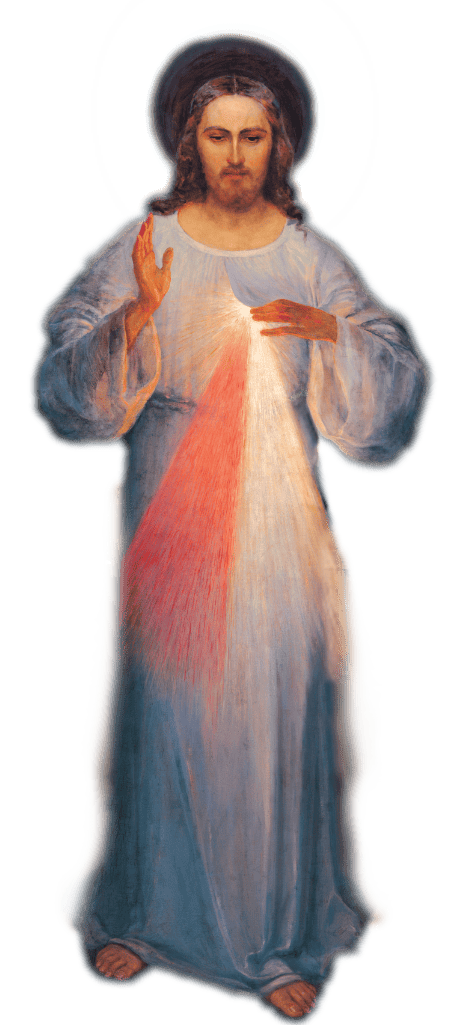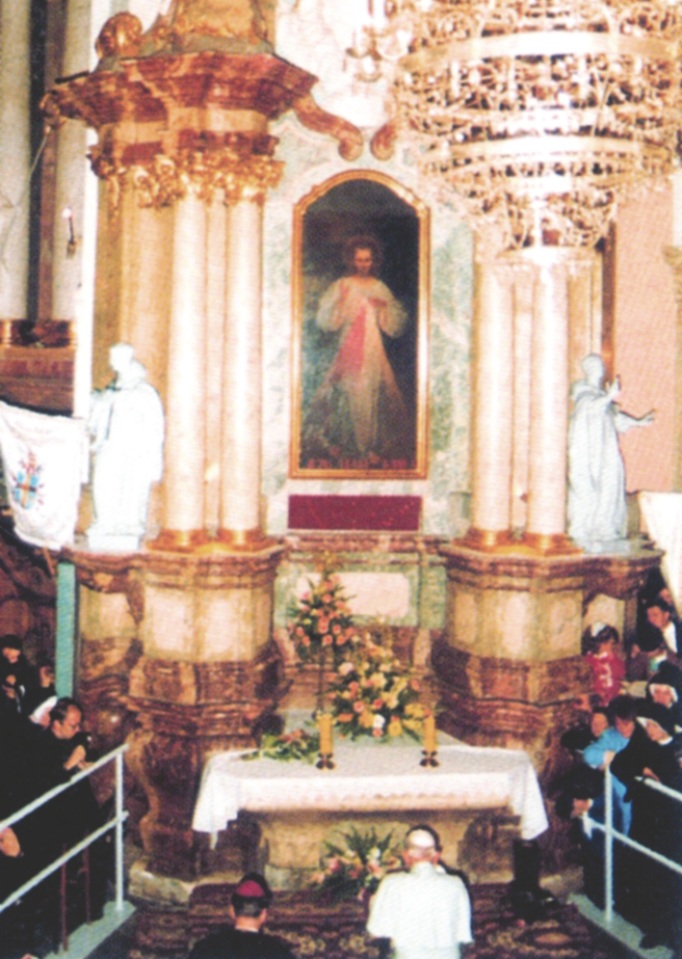THE FIRST IMAGE OF THE MERCY OF JESUS
Płock [Poland] “February 22, 1931: In the evening, while I was in my cell, I saw Jesus dressed in a white garment. One hand was raised in a gesture of blessing; the other hand touched His garment at the breast. From under the garment, slightly drawn to one side at the breast, two rays of light came forth, one red and the other pale. In silence, I kept my gaze fixed on the Lord; my soul was amazed, but also filled with joy. After a while, Jesus said to me: paint a picture according to the pattern you see, with the inscription: Jesus, I trust in You. (…) I promise that the soul who venerates this picture will not perish. I also promise to conquer the enemy of that soul here on Earth, especially at the hour of death… (Diary, 47-53).
The task that Jesus gave to Sister Faustina was beyond human capacity because she lacked even basic artistic skills. She tried to follow God’s will by seeking help from one of her sisters to paint the picture. But that did not work. On the one hand, she was urged by Jesus to complete the work and on the other hand, she had to face the skepticism of her confessors and supervisors. This led to great personal suffering for Sister Faustina.
During her stay in Płock (more than 2 years), and then in Warsaw, Sister Faustina constantly thought about Jesus’ outstanding request, especially because He showed her the importance of this task in His plan. “Suddenly, I saw the Lord saying to me: Know that if you neglect to paint the picture and the whole work of My mercy, you will have to pay for it for countless souls on the day of judgment” (Diary, 154). After her perpetual vows, Sister Faustina was transferred to the convent in Vilnius (May 25, 1933).
Here she found the help she had promised – her confessor and spiritual director, Father Michael Sopoćko, who made an effort to fulfill Jesus’ request. Father Sopoćko introduced part of Sister Faustina’s mission to the artist and made him swear to secrecy. In painting the image of the Merciful Jesus, this respected and learned artist (Eugeniusz Kazimirowski) abandoned his own artistic vision to painstakingly paint what Sr. Faustina requested. She visited the artist’s studio (together with Sr. Borgia) at least once a week for six months to point out necessary additions and corrections. Father Sopoćko was actively involved in the painting, trying to ensure that the image of Jesus was reproduced exactly according to Sr. Faustina’s instructions.
The time they spent together painting the painting became an opportunity to gain a deeper understanding of the nature of the painting. Any disputes were resolved by Jesus himself (Diary 299; 326; 327; 344). The conversation between Sr. Faustina and Jesus about the painted image is very meaningful.
“When I visited the painter who was painting the picture and saw that it was not as beautiful as Jesus, I felt very sad, but I hid this deep in my heart. (…) The Mother Superior stayed in town to take care of some matters while I returned home alone. I went to the chapel immediately and cried a lot. I said to the Lord, “Who will paint You as beautiful as You?”. Then I heard these words: not in the beauty of the color, or in the stroke of the brush, but in My grace” (Diary, 313).
From this conversation emerges the honesty of one endowed with supernatural grace, who saw – in his mystical experiences – the true beauty of the Risen Savior.
The Lord Jesus appeared to Sister Faustina many times in the form presented in the image (Diary 473; 500; 560; 1047; 1565), and He also made many requests that this icon, which He had sanctified with His living presence, be publicly venerated.
Thanks to the efforts of Father Sopoćko, on April 26-28, 1935, at the “Gate of Dawn” in Vilnius, the image of the Merciful Savior was publicly venerated for the first time during the solemn ceremony concluding the Holy Year commemorating the 1900th anniversary of the Redemption of the World. On the last day of the celebration – the first Sunday after Easter – the ceremony was attended by Sister Faustina. The sermon on Divine Mercy was given by Father Sopoćko, as Jesus had requested.
“For three days the statue was exposed and venerated publicly. Because it was placed right above a window at the “Gate of Dawn”, it could be seen from a great distance. During these three days, the closing ceremony of the Jubilee of the Redemption of the World was celebrated at the “Gate of Dawn”, marking the one thousand nine hundred years that had passed since the Passion of the Savior. Now I see that the work of Redemption is linked to the work of mercy which Our Lord asks of us” (Diary, 89).
“When the statue was exposed, I saw the hand of Jesus suddenly move, as he made a great sign of the cross. That same evening, (…) I saw the statue fly over the town, and the town was covered with what looked like a net. When Jesus passed by, he cut all the nets…” (Diary, 416).
“When I visited the painter who was painting the picture and saw that it was not as beautiful as Jesus, I felt very sad, but I hid this deep in my heart. (…) The Mother Superior stayed in town to take care of some matters while I returned home alone. I went to the chapel immediately and cried a lot. I said to God, “Who will paint you as beautiful as you?” Then I heard these words: not in the beauty of the color, nor in the stroke of the brush, but in My grace” (Diary, 313).
From this conversation emerges the honesty of one endowed with supernatural grace, who saw – in his mystical experiences – the true beauty of the Risen Savior.
Jesus appeared to Sister Faustina many times in the form presented in the image (Diary 473; 500; 560; 1047; 1565), and He also made many requests that this painting, which He had sanctified with His living presence, be publicly venerated.
Thanks to the efforts of Father Sopoćko, on April 26-28, 1935, at the “Gate of Dawn” in Vilnius, the image of the Merciful Savior was publicly venerated for the first time during the solemn ceremony concluding the Holy Year commemorating the 1900th anniversary of the Redemption of the World. On the last day of the celebration – the first Sunday after Easter – the ceremony was attended by Sister Faustina. The sermon on Divine Mercy was delivered by Father Sopoćko, as Jesus had requested.
“For three days the image was exposed and venerated publicly. Because it was placed right above a window at the “Gate of Dawn”, it could be seen from a great distance. During these three days, the closing ceremony of the Holy Year of the Redemption of the World was celebrated at the “Gate of Dawn”, marking the one thousand nine hundred years that had passed since the Passion of the Savior. Now I see that the work of Redemption is linked to the work of mercy which Our Lord asks of us” (Diary, 89).
“When the image was exposed, I saw the hand of Jesus suddenly move, as He made a great sign of the cross. That same evening, (…) I saw the image fly over the town, and the town was covered with what looked like a net. When Jesus passed by, He cut all the nets…” (Diary, 416).
“Near the end of the ceremony, when the priest took the Blessed Sacrament to bless the people, I saw Jesus as He is depicted in the image. He gave His blessing, and rays of light spread throughout the world. Suddenly I saw an impenetrable light in the form of a crystalline dwelling, woven from waves of brilliance that neither creatures nor spirits could reach. Three doors led into this brilliance. At that moment, Jesus, as He is depicted in the image, entered this brilliance through the second door that led to Inner Unity” (Diary, 42
0)
On April 4, 1937, after being positively reviewed by experts, with the permission of the Metropolitan Archbishop of Vilnius, Romuald Jałbrzykowski, the image of the Merciful Saviour was blessed and placed in Saint Michael’s Church in Vilnius. In that church, beautifully exposed in an impressive gilded frame next to the high altar, it was venerated and given numerous votive offerings. It emanated holiness, and the devotion to Divine Mercy quickly spread beyond the borders of Vilnius. Miraculously, irrespective of physical limitations, it reached millions of people all over the world.
In her later correspondence, Sr. Faustina wrote to Fr. Sopoćko:
“The Lord let me know that He was pleased with what had been done. Immersed in prayer and the closeness of the Lord, I experienced great peace in my soul regarding this whole work. (…) And now, regarding these paintings (small copies), (…) people are buying them little by little so far and many souls have experienced the grace of God through this source. As with everything, this will take time. These paintings are not as beautiful as the large ones. They are bought by those who are attracted by the grace of God…” (Cracow, February 21, 1938).
As a result of World War II and the Soviet annexation of Lithuania, the statue of the Merciful Jesus became inaccessible to pilgrims for decades. Despite the many dangers, the statue was hidden in an attic, rolled up several times, stored in unfavorable conditions (damp and freezing), and restored in a terrible way. By God’s providence, the painting miraculously survived the Communist era.
During his pilgrimage to Lithuania, on September 5, 1993, Pope John Paul II prayed before the image of the Merciful Jesus in the Church of the Holy Spirit in Vilnius. In his homily to the faithful, he called this image “THE HOLY ICON”.
In the history of the apparitions, there is only one known incident when Jesus expressed the desire to have His image painted. He presented and approved His artistic image himself – as evidenced by His living presence, repeatedly shown to Sister Faustina in a painted image. Furthermore, by promising special graces to those who adored this image, He gave it an extraordinary religious value.

